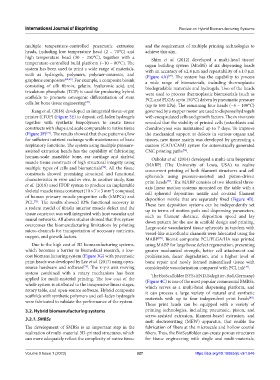Page 335 - IJB-9-1
P. 335
International Journal of Bioprinting Review on Hybrid Biomanufacturing Systems
multiple temperature-controlled pneumatic extrusion and the requirement of multiple printing technologies to
heads, including low temperature head (2 – 70°C) and achieve this aim.
high temperature head (30 – 250°C), together with a Shim et al. (2012) developed a multi-head tissue/
temperature-controlled build platform (−10 – 80°C). The organ building system (MtoBS) of six dispensing heads
system has been used to print a wide range of materials, with an accuracy of ±2.4 µm and repeatability of ±1.0 µm
such as hydrogels, polymers, polymer-ceramics, and (Figure 4A) . The system has the capability to process
[75]
graphene composites [68,69] . For example, a composite bioink a wide range of biomaterials, including thermoplastic
consisting of silk fibroin, gelatin, hyaluronic acid, and biodegradable materials and hydrogels. Two of the heads
tricalcium phosphate (TCP) is used for producing hybrid were used to process thermoplastic biomaterials (such as
scaffolds to promote osteogenic differentiation of stem PCL and PLGA; up to 150°C) driven by pneumatic pressure
cells for bone tissue engineering . (up to 650 kPa). The remaining four heads (−5 – 100°C)
[70]
Kang et al. (2016) developed an integrated tissue-organ governed by a stepper motor are used to dispense hydrogels
printer (ITOP) (Figure 3E) to deposit cell-laden hydrogels with encapsulated cells and growth factors. The in vivo tests
together with synthetic biopolymers to create tissue revealed that the viability of printed cells (osteoblasts and
constructs with shape and scale comparable to native tissue chondrocytes) was maintained up to 7 days. To improve
(Figure 3F) . The results showed that these patterns allow the mechanical support at defects in various organs and
[71]
for sufficient nutrient exchange with maintenance of basic tissues, new tissue matrix was developed by generating a
respiratory functions. The system using multiple pressure- custom (CAD/CAM) system for automatically generated
assisted extrusion heads has the capability of fabricating CNC printing paths .
[76]
human-scale mandible bone, ear cartilage and skeletal Ozbolat et al. (2014) developed a multi-arm bioprinter
muscle tissue constructs of high structural integrity using (MABP) (The University of Lowa, USA) to realize
multiple types of cells and biomaterials . All the tissue concurrent printing of both filament structures and cell
[72]
constructs showed promising structural and functional spheroids using pressure-assisted and piston-driven
characteristics in vitro and in vivo. In another study, Kim print heads . The MABP consists of two identical three-
[77]
et al. (2018) used ITOP system to produce an implantable axis linear motion systems mounted on the table with a
skeletal muscle tissue construct (10 × 7 × 3 mm ) composed cell spheroid deposition nozzle and co-axial filament
3
of human primary muscle progenitor cells (hMPCs) and deposition nozzle that are separately fixed (Figure 4B).
PCL . The results showed 82% functional recovery in These two deposition systems can be independently set
[73]
a rodent model of tibialis anterior muscle defect and the up in terms of motion path and dispensing parameters,
tissue construct was well integrated with host vascular and such as filament distance, deposition speed and lay
neural networks. All above studies showed that this system down pattern for the use in scaffold design and printing.
overcomes the biomanufacturing limitations by printing Large-scale vascularized tissue spheroids in tandem with
micro-channels for transportation of necessary nutrients, vessel-like microfluidic channels were fabricated using the
oxygen, and growth factors.
[78]
MABP . Bioink composite PCL/PLGA/HA was printed
Due to the high cost of 3D biomanufacturing systems, using MABP for large bone defect regeneration, presenting
which becomes a barrier to biomedical research, a low- greater mechanical strength, better cell attachment and
cost biomanufacturing system (Figure 3G) with pneumatic proliferation, faster degradation, and a higher level of
print heads was developed by Lee et al. (2017) using open- bone repair and newly formed mineralized tissue with
[74]
source hardware and software . The x-y-z axis moving considerable vascularization compared with PCL ink .
[79]
system combined with a rotary mechanism has been The BioScaffolder (SYS+END, Salzgitter‑Bad, Germany)
applied for multi-material printing. The low cost of the (Figure 4C) is one of the most popular commercial BMBSs,
whole system is attributed to the inexpensive linear stages, which serves as a multi-head dispensing platform, and
rotary table, and open-source software. Hybrid composite it can process a large variety of natural and synthetic
scaffolds with synthetic polymers and cell-laden hydrogels materials with up to four independent print heads .
[80]
were fabricated to validate the performance of the system.
These print heads can be equipped with a variety of
3.2. Hybrid biomanufacturing systems printing technologies, including pneumatic, piston, and
screw-assisted extrusion, filament-based extrusion, and
3.2.1. SMBSs melt electrowriting (MEW) apparatus, that enable the
The development of SMBSs is an important step in the fabrication of fibers at the microscale and hollow coaxial
realization of multi-material 3D-printed structures, which fibers. Thus, the BioScaffolder can create porous structures
can more adequately reflect the complexity of native tissue for tissue engineering with single and multi-materials,
Volume 9 Issue 1 (2023) 327 https://doi.org/10.18063/ijb.v9i1.646

